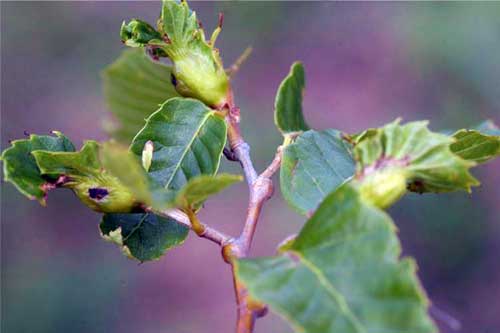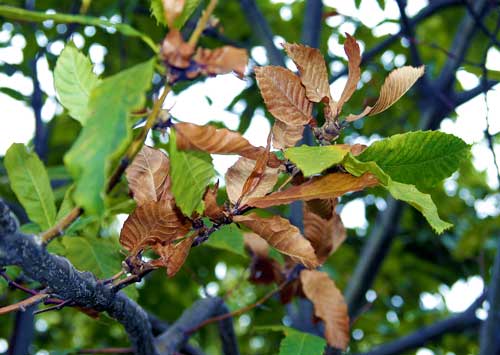Time to start looking for signs of gall wasps in chestnuts
We are approaching the ideal time for Michigan chestnut growers to scout for Asian chestnut gall wasps. Leaves often remain attached to the galls during fall and winter, making them highly visible.
Michigan chestnut growers should be aware of the threat from Asian chestnut gall wasps (Dryocosmus kuriphilus), a potentially devastating invasive pest that can infest all species in the genus Castanea including American chestnut, ornamental species and those planted for nut production. At this time, Asian chestnut gall wasps have not been found in Michigan, but growers should understand the quarantine affecting chestnut plant material and scout for this pest regularly to ensure early detection.
No chestnut plant material – except seed – can be brought into Michigan from Alabama, Connecticut, Georgia, Kentucky, Maryland, Massachusetts, North Carolina, Ohio, Pennsylvania, Tennessee, Virginia or any other state where gall wasp becomes established. Exceptions are made if the nursery is certified as free from Asian chestnut gall wasps for three years. Check for an updated Michigan Department of Agriculture and Rural Development quarantine list before ordering materials.
Asian chestnut gall wasps are native to Asia and were first reported in the United States in 1974. They were observed on Chinese chestnut in Georgia after being introduced on imported plant material. From Georgia, the geographic range expanded reaching Virginia (2001), Ohio (2002), Kentucky (2003), Maryland and Pennsylvania (2006), Connecticut (2011), Massachusetts and Ontario (2012). Asian chestnut gall wasps will likely continue to spread across eastern North America through natural dispersal and by means of infested plant material.
Asian chestnut gall wasps produce one generation per year via asexual reproduction. Adult females lay eggs inside buds in early summer and eggs hatch soon after. After egg hatch, the larvae remain inactive until bud break the following spring, when they induce the formation of galls (Photo 1). Galls can form on the stem, petiole or leaf and provide the larvae and pupae protection. Adults emerge from galls in the early summer and locate new chestnut shoots, laying eggs for the next generation.

Photo 1. Leaf distortion and gall formation caused by Asian
chestnut gall
wasps on chestnut.
After the wasps emerge, galls become woody and dry out, potentially persisting on the tree for several years (Photo 2). Asian chestnut gall wasps are a potentially devastating exotic insect that cause globular twig, shoot and leaf galls on actively growing shoots of all Castanea species. Galling reduces fruiting and nut yield, suppresses shoot elongation, reduces tree vigor and wood production, and kills trees. Galling also prevents infested shoots from producing new shoot growth and reproductive flowers, thereby reducing or eliminating future production.

Photo 2. Shoot damage and dead leaf retention caused by gall
formation.
The easiest way to scout for the Asian chestnut gall wasps is to visually inspect for galls. Scouting can take place at any time of the year as the galls persist on the tree even after the wasps emerge in early summer. Leaves often remain attached to the galls during the winter, making them highly visible at that time.
Think you’ve found Asian chestnut gall wasp in Michigan? Contact Michigan State University Extension IPM educator Erin Lizotte at 231-779-9480.
Dr. Fulbright’s work is funded in part by MSU’s AgBioResearch.



 Print
Print Email
Email


